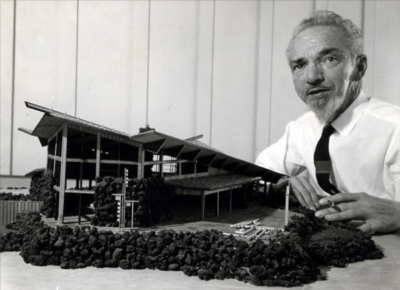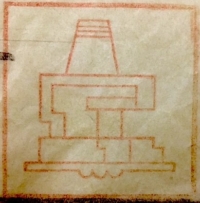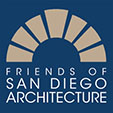By Vonn Marie May

Sim Bruce Richards is considered one of our region’s most influential post-WWII Modern-Contemporary architects, and is recognized as a Master Architect by the City of San Diego. Raised in Oklahoma and home schooled by his half-Cherokee Native American mother he qualified to enter the University of California Berkeley where he majored in art during the austere days of the Depression. As a young student he took up the craft of weaving fabrics and rugs. His works were so exceptional he was invited to display them at a gallery exhibition in Berkeley. As fate would have it, the American master architect Frank Lloyd Wright was visiting the college town as a lecturer and saw Richard’s weavings. Wright was so impressed with the work he tracked the artist down and personally invited him to attend his school of architecture outside Madison, Wisconsin, the renowned Taliesin, to which Richards consented. Richards trained in that experimental setting and was among the first class to make the move to Wright’s Taliesin West outside Phoenix, Arizona. Working and learning under the irascible Wright, Richards design sensibilities and innovation continued to mature, according to a 2003 interview with his wife, Janet Richards.
Richards served as civilian Naval architect during WWII which landed him in San Diego. Despite not obtaining an architectural degree Richards began his architectural design career based on his love of nature and art. He briefly worked with Harold Abrams and William Templeton Johnson, two seasoned master architects in San Diego. In 1945 Richards set up his own shop above El Campo Santo Cemetery in Old Town San Diego. He once remarked, “I have it all fixed that when I drop they will just roll me down the hill.”
 All of the residences and limited public or commercial buildings attributable to Richards were of wood construction, usually incense cedar with rough finishes, natural and never painted. James Britton, San Diego Magazine critic, wrote of Richards in the Union-Tribune: “The weathered look of an unpainted house is decidedly hard for many people to adjust to but once the adjustment has been made a fondness arises that makes other houses look garish by comparison. The confirmed Richards’ client is not more likely to put paint on his house than to put pants on the family dog.”
All of the residences and limited public or commercial buildings attributable to Richards were of wood construction, usually incense cedar with rough finishes, natural and never painted. James Britton, San Diego Magazine critic, wrote of Richards in the Union-Tribune: “The weathered look of an unpainted house is decidedly hard for many people to adjust to but once the adjustment has been made a fondness arises that makes other houses look garish by comparison. The confirmed Richards’ client is not more likely to put paint on his house than to put pants on the family dog.”
Richard’s contemporary architectural design work, even as the foremost exponent of Frank Lloyd Wright in San Diego, remained expressions of his personal process, informed by his training, his experimental nature, and his upbringing: “his mother taught him geometry at her knee,” according to Wright expert Spencer Lake. He responded to a semi-arid coastal desert region, reflected in natural woods and stonework, while expressing those influences in a modernist context. Many of his Southern California peers were working in altogether different media and materials and were responding to the emergent car culture. Richards was the antithesis of the 1950s Googie trend and its indulgences. His painfully organic truths set him apart and further developed his acerbic editorial wit.
Richards was involved in pertinent civic issues. He supported the Sierra Club, the Citizens Coordinate for Century Three (C3), a land use advocacy group founded by another local Organic architect, Lloyd Ruocco. He served as president of the San Diego chapter of the American Institute of Architects. He assisted James Hubbell in the founding of the Ilan Lael Foundation which encourages creativity and aesthetic quality in San Diego.
For a 1983 exhibition of Richards’ work to be held at the Natural History Museum, Esther McCoy, Spencer Lake, and other friends of Bruce were putting finishing touches on their presentations when they were informed of his passing. The exhibition, turned into a memorial but went forward producing the companion document, NATURE IN ARCHITECTURE: the work of sim bruce richards.
McCoy, a distinguished architectural historian, wrote “An Appreciation” in NATURE IN ARCHITECTURE:
He [SBR] was one of a small band of architectural dissenters which every city harbors — or should harbor, if art is to live and renew itself. During the ‘50s and ‘60s when architecture became more tightly organized, the path forked, the Miesians on the high road, the Wrightians on the low road. … The architectural misfits tripled during the ‘50s. They were often westerners, like Bruce. … Art and architecture became one for Bruce, forever inseparable.
Another architectural historian, Edgar Kaufmann, Jr., notes in the same publication:
Sim Bruce Richards is a young U.S. artist. There are not too many of them in evidence. An artist mediates between stimuli and expressed works. Very seldom is the flow from stimulus to artist as strong, as true, as deep, as with Bruce.
Sources:
Lake, Spencer: NATURE IN ARCHITECTURE: the work of sim bruce richards; Maurine & John L. Cox, 1983
Modern San Diego: www.modernsandiego.com
Olten, Carol: “Sim Richards had his own style”; San Diego Union, 8 April 1984
San Diego, City of: Modernism Context Statement; 2007
San Diego Union, Obituary: “Sim Richards, noted architect, dies at 75”; 19 December 1983.
Images:
Sim Bruce Richards – Courtesy of modernsandiego.com
Sim Bruce Richards ~ Architectural Drawings Cartouche in Title Block (Enchanted Mesas)
